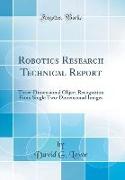Robotics Research Technical Report
BücherAngebote / Angebote:
Excerpt from Robotics Research Technical Report: Three-Dimensional Object Recognition From Single Two-Dimensional ImagesMuch recent research in computer vision has been aimed at the reconstruction of depth information from the two-dimensional visual input. An assumption underlying some of this research is that the recognition of three-dimensional objects can most easily be carried out by matching against reconstructed three-dimensional data. However, there is reason to believe that this is not the primary pathway used for recognition in human vision and that most practical applications of computer vision could similarly be performed without bottom-up depth reconstruction. Although depth measurement has an important role in certain visual problems, it is often unavailable or is expensive to obtain. General-purpose vision must be able to function effectively even in the absence of the extensive information required for bottom-up reconstruction of depth or other physical properties. In fact, humanvision does function very well at recognizing images, such as simple line drawings, that lack any reliable clues for the reconstruction of depth prior to recognition. This capability also parallels many other areas in which human vision can make use of partial and locally ambiguous information to achieve reliable identifications. This paper presents several methods for bridging the gap between two - dimensional images and knowledge of three dimensional objects without any preliminary derivation of depth. Of equal importance, these methods address the critical problem of robustness, with the ability to function in spite of missing data, occlusion, and many forms of image degradation.How is it possible to recognize an object from its two-dimensional projection when we have no prior knowledge of the viewpoint from which we will be seeing it? An important role is played by the process of perceptual organization, which detects groupings and structures in the image that are likely to be invariant over wide ranges of viewpoints. While it is true that the appearance of a three-dimensional object can change completely as it is viewed from different viewpoints, it is also true that many aspects of an object's projection remain invariant over large ranges of viewpoints (examples include instances of connectivity, collinearity, parallelism, texture properties, and certain symmetries). It is the role of perceptual organization to detect those image groupings that are unlikely to have arisen by accident of viewpoint or position. Once detected, these groupings can be matched to corresponding structures in the objects through a knowledge-based matching process. It is possible to use probabilistic reasoning to rank the potential matches in terms of their predicted reliability, thereby focusing the search on the most reliable evidence present in a particular image.About the PublisherForgotten Books publishes hundreds of thousands of rare and classic books. Find more at www.forgottenbooks.comThis book is a reproduction of an important historical work. Forgotten Books uses state-of-the-art technology to digitally reconstruct the work, preserving the original format whilst repairing imperfections present in the aged copy. In rare cases, an imperfection in the original, such as a blemish or missing page, may be replicated in our edition. We do, however, repair the vast majority of imperfections successfully, any imperfections that remain are intentionally left to preserve the state of such historical works.
Folgt in ca. 10 Arbeitstagen


